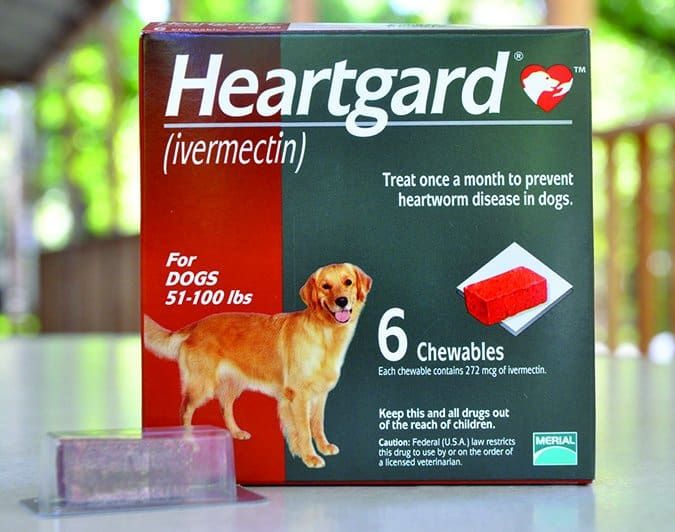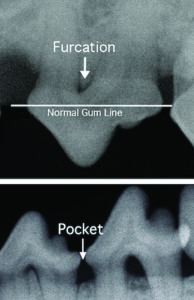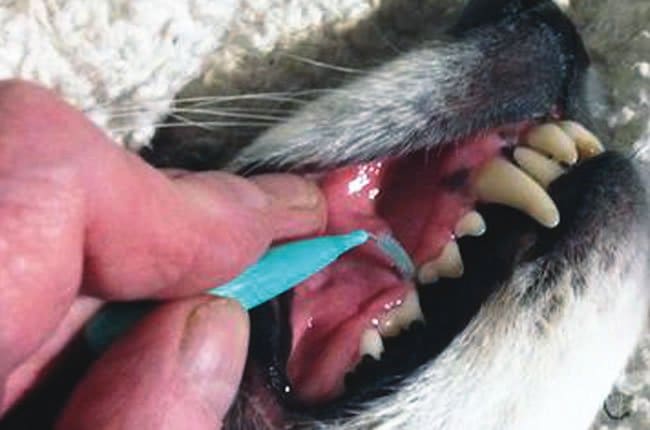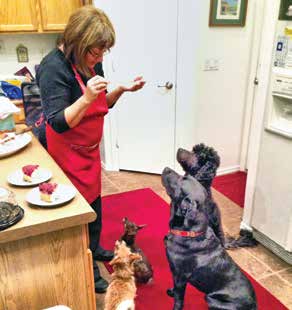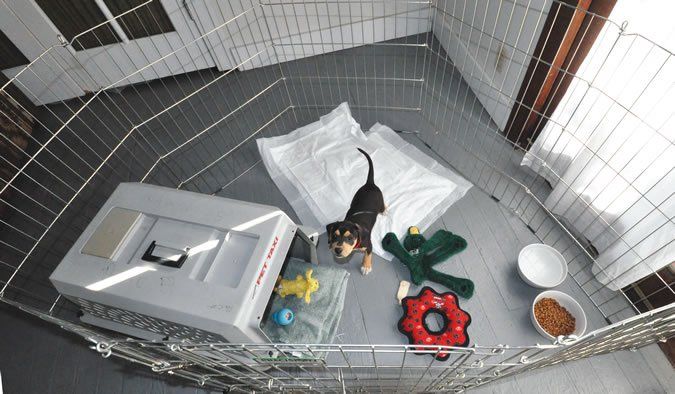
Heartworms might more accurately be called heart-and-lung-worms; these life-threatening parasites are almost as frequently found in the lungs of infected dogs as their hearts. But perhaps the term also references the owners of infected dogs, because when we learn our beloved dog has been diagnosed with these horrid parasites, our hearts are very much affected, if only figuratively. Treatment for heartworm can be risky, expensive, and inconvenient – altogether, quite a source of fear and anxiety for dog owners. The more information you have before initiating treatment, though, the better you will be able to support your dog through the process.
Jennifer Dodge of Wichita, Kansas, knows that fearful, anxious feeling all too well. In 2010, she rescued Holly, who had been living on the streets for three years after her owners abandoned her. Wary of strangers and covered with mange, Holly was underweight and had a disturbingly deep cough.
When Holly’s heartworm test came back positive, Dodge was devastated. “I had never been through this before,” she remembers. “And I thought, ‘I just lost this poor dog.'”
After canvassing the Internet for as much information as she could find, Dodge started a Facebook page called Heartworm Survivor, where other owners of dogs who had gone through treatment for a heartworm infection could share their experiences and resources. Most people who post there have specific questions about heartworm treatment and potential alternatives. Most significantly, people who come to the page want reassurance that there is a light at the end of the tunnel.
Heartworm experts stress that when it comes to this disease, prevention is the best defense, because no treatment is without risk. But for those who are weighing the pros and cons of different treatment options, it is comforting to know that the choices have gotten better than they used to be.
How Heartworm Spreads
According to Dr. Stephen Jones of the American Heartworm Association, at least 1 million American dogs are infected with heartworm at any given time.
Heartworms are transmitted by mosquitos. When a mosquito bites and drinks the blood of a heartworm-infected animal (host species include dogs, coyotes, foxes, wolves, and ferrets), it also inadvertently consumes microscopic larvae. These larvae, called microfilariae, are little more than fertilized eggs that are produced by adult female heartworms after mating with adult male heartworms. The microfilariae circulate in the host animal’s blood, but can’t develop into adults in that host; they can develop further only in the digestive tract of a mosquito. It takes about two weeks of camping out in the mosquito that consumed them for the microfilariae to develop into their next life-form: infective larvae.
Once they have reached this stage, the larvae can abandon their mosquito host when it bites another animal, swimming out in the mosquito’s saliva. Once they have been deposited under the skin of their new and final mammal host, they develop into their next life stages. First, they transform into larvae that burrow through the animal’s muscle tissue toward the major blood vessels, a journey that takes about 45 to 60 days. Once there, the larvae develop into immature worms, and make their way through the circulatory system to the major pulmonary arteries. There they continue to mature and grow, reaching reproductive adulthood in about six to seven months.
The heartworm tests used in most veterinary practices detect hormones produced by adult female heartworms. This means it’s possible for a dog whose test is “negative” to be infected; if the dog was infected with larvae less than seven months prior to the test, his heartworms won’t be mature enough to produce the adult female hormones that the test is designed to detect. It’s also possible (though not common) for a dog to be infected with only male worms, who won’t, of course, produce those female hormones that the test looks for.
“There are probably more false negatives than we realize,” says Dr. Jones, noting that some dogs carry antibodies to the antigen used in the heartworm test: Though these dogs may indeed be infected, their results will come back as clear. “There are ongoing studies now looking at shelter pets who have negative tests,” he says, “and they are finding a large percent of those samples are actually positive.”
Geography has always been a key indicator in heartworm prevalence: Those parts of the country where mild temperatures mean an extended, if not perpetual, mosquito season, such as the Gulf Coast, the South, and Hawaii, have long had endemic heartworm problems.
But increasingly, says Dr. Jones – who practices in Moncks Corner, South Carolina, itself a high-risk state for heartworm infestation – the disease has pushed out from those historic boundaries.
“Follow the Mississippi River up through Ohio, go to a big city like Chicago and other parts of the country that you might think would be too cold, and there are practices there seeing 100 cases of heartworm a year,” he says. And in locales where the disease is endemic, increased exposure raises the worm load that a dog might be carrying.
In addition to climate, sociodemographics can play a role in the spread of heartworm: Communities whose residents cannot afford monthly heartworm prevention often have reservoirs of infected dogs. Since wild canids can harbor the disease, growing populations in increasing proximity to human residences – in particular, the coyote boom – mean greater risk, too.
Arsenic as a Heartworm Treatment
Arsenic, that old favorite of surreptitious murderers in mystery novels, is the treatment of choice for heartworms, too. Today, veterinary medicine uses an analog of the notoriously poisonous metalloid: melarsomine dihydrochloride, sold under the brand name Immiticide, which was introduced to the market in 1995.
Compared to Caparsolate, the only other drug that has ever been approved to kill adult heartworms, Immiticide is a vast improvement. The use of Caparsolate gave rise to the sentiment that the cure for heartworm was arguably as bad as the disease itself; side effects were common and dramatic, and the drug wasn’t even that effective – it killed all the adult heartworms in less than half of the dogs treated with it.
In contrast, when used as directed, Immiticide kills 98 percent of the heartworms present, and is metabolized very quickly. “The dose administered doesn’t take long to get out of the body, and it doesn’t pose great risk to liver and kidney function,” Dr. Jones says. The injection needs to be administered deep in the muscle, and can cause soreness, pain and, sometimes, permanent lumps or abscesses at the injection site.
Typically, for a dog with “severe” disease (referred to as a “Stage 3 infection,”) veterinarians administer one injection of Immiticide, and send the dog home for a month, during which the owner is instructed to severely curtail the dog’s movements (more about that in a moment). Thirty days after that first dose, another injection is given, usually followed a day later by a third and final injection. Ninety-eight percent of dogs treated in this way (regardless of the state of disease) will be cleared of heartworms.
If the dog has Stage 1 or 2 disease (a mild to moderate infection), the vet may administer a second injection 24 hours after the first one. About 90 percent of dogs with Stage 1 or 2 infections will be cleared of adult heartworms by this protocol. A third injection would be indicated if the dog still tests positive four months after treatment. Because of the higher efficacy rate of the three-injection protocol recommended for Stage 3 dogs, many vets use the same protocol for even Stage 1 and 2 dogs.
Some (not all) veterinarians require overnight hospitalization after each injection so the dog can be monitored for adverse effects, especially if the test results indicated that the dog had a heavy worm burden (as indicated by high heartworm antigen levels).
The biggest problem with conventional heartworm treatment is its aftermath: The treatment kills the adult worms – and suddenly, the dog has a bunch of dead and decaying worms in his major blood vessels and lungs. It takes a bit of work for the body to clear out the dead worm corpses, which are protected by a tough cuticle surface. “When you kill a worm, it becomes a limp spaghetti noodle,” Dr. Jones explains. “It crumples into the artery, much like a spaghetti noodle in the sink drain. As the worms decompose, they can trigger blood clots, which can cause more blockage.”
During this time, dogs must be kept as quiet as possible and inactive, ideally in a crate or small pen. Most vets recommend that the dog be taken out to potty only on a leash, and then returned to a crate. Roughhousing with other dogs, or even a quick romp back into the house after pottying, can raise the heart rate and increase the risk of embolisms.
All dogs should be maintained on heartworm preventive medications throughout and following treatment, and tested four to six months after treatment, to ensure the infection has been completely cleared.
Irreparable Damage from Heartworm
The danger is greater for dogs who have particularly severe heartworm infections (many adult worms) or whose circulatory and respiratory systems have been damaged by a long-term infection. Some of the effects that can result from a severe heartworm infection include:
- All sorts of vascular disease: thickened or damaged pulmonary blood vessels; thrombosis (clotting), nodules on the inside of the blood vessels (granulomas caused by a chemical reaction to the attachment of the worms), inflamed blood vessels.
- Reduced cardiac output with resulting hypertension (high blood pressure), which can lead to heart enlargement and heart failure.
- Fluid accumulation in peritoneal cavity and lungs, cough, shortness of breath, exercise intolerance.
- Caval syndrome – typically associated with large numbers of adult heartworms in the pulmonary arteries, causing pallor, tachycardia, sudden collapse, as well as hemolytic anema (red blood cells are destroyed and removed from the bloodstream before their normal lifespan is over), hemoglobinemia (excessive amounts of hemoglobin in the blood plasma), and hemoglobinuria (when unusually high concentrations of hemoglobin are found in the urine).
To visualize the damage that heartworms do, Dr. Jones has necropsied more than three dozen dogs who had been successfully treated for heartworm, and all, he said, had noticeable damage in the pulmonary arteries as a result of the infection. “I still found dead pieces of mummified worms, thickening of the arteries caused by nothing other than heartworm,” he says. “I’ve never found a dog that didn’t have long-term disease, scarred lung lobes, vascular disease, or lung tissue damage. The scar tissue doesn’t go away.”
Dr. Jones notes that a dog’s body can do a tremendous amount to compensate for lost lung function. A heartworm-positive dog may appear clinically normal, perhaps only getting winded a bit early after intense physical exertion. “It’s really hard to clinically judge the real function of lungs and arteries in a dog who appears normal,” he says.
Mitigating Heartworm Treatments
Depending on the condition of the dog and the stage of his disease, stabilizing treatments may need to be administered before or concurrently with treatment for the heartworm infection. A dog with serious damage to his circulatory and respiratory systems may require therapy with corticosteroids (to reduce inflammation), diuretics (to reduce the excessive fluid in his lungs or peritoneal cavity and reduce that burden on his circulatory system), vasodilators (to improve blood flow), and/or positive inotropic agents (drugs that strengthen the contractions of the heart, so it can pump more blood with fewer heartbeats).
Dead worms don’t just disappear; it’s the disposal of their dead bodies, in fact, that causes the major difficulties of heartworm treatment. To understand why, remember how the heart works with the lungs: The gas exchange that enables life takes place in the tiny air sacs (alveoli) in the lungs, where carbon dioxide is released into the lung for exhalation, and oxygen is taken into the blood vessels for distribution throughout the body. The heart provides the driving force for this gas exchange, driving oxygen-rich blood from the alveoli out to the body, as well as driving the “used” blood, now full of carbon dioxide and other waste products from the various tissues of the body, back to the lungs for disposal.
As the heartworms die and lose their attachment to the interior of the dog’s heart, lungs, and pulmonary arteries, and as their bodies are released into the bloodstream, the decaying fragments are deposited into the alveoli, where they can plug up the bronchioles and cause tissue death in the lungs. This, in turn, can cause fluid accumulation (as the lungs are overburdened by this new task), coughing, gagging (to the point of causing vomiting), and bacterial infections.
Dogs should be closely monitored and supported through this process. They may feel so weak that they refuse food and water; if they don’t drink (especially if they develop a bacterial infection and resulting fever), they can become dehydrated, which can complicate their recovery further. Sometimes supportive fluids (IV or subcutaneous), antibiotics, and/or corticosteroids may be needed to address these secondary symptoms.
In recent years, it’s become more common for veterinarians to pre-treat their heartworm patients (especially those dogs with Stage 3 infections) with doxycycline – sometimes, for as long as a month before the conventional Immiticide treatment. This pre-treatment reduces the occurrence of bacterial infections and adverse secondary symptoms once the Immiticide is administered.
How Heartworms Die
Jennifer Dodge says one of the most often asked questions on the Heartworm Survivor Facebook page is whether to consider the so-called “slow kill” method for heartworm infection. In this approach, instead of Immiticide, the dog receives a long-term program of ivermectin (the same drug used as a heartworm preventive drug) and daily doxycycline (an antibiotic).
The ivermectin kills any larvae that have been deposited by mosquitoes (preventing the development of any more adult worms) as well as the microfilariae that the adult worms are producing (which interrupts the reproduction cycle and reduces the chance that the dog will be a reservoir to infect other dogs).
The doxycycline accomplishes two things: First, it kills Wolbachia, a symbiotic rickettsial organism living inside the heartworms (yes, parasitic heartworms have their own parasites!), and the death of the Wolbachia seems to weaken the weakest heartworms. The doxycycline also renders the adult female worms unable to reproduce. Eventually, the worms die, but it is a process that can take 18 to 24 months.
Proponents of the slow-kill protocol say that it’s kinder on the body, allowing the worms to die gradually so they don’t burden the dog’s lungs by dying (and decaying) all at once. A 2008 study published in Veterinary Parasitology showed that after nine months, dogs treated with ivermectin and doxycycline showed a 79 percent reduction in worms (compared to 100 percent for those treated with Immiticide alone).
Still, many veterinarians, as well as the American Heartworm Association, caution against the approach. “It’s not the first line of treatment for heartworm disease,” says Herb Maisenbacher, VMD, of Veterinary Heart Care in Virginia Beach, Virginia. “Yes, it doesn’t sound good to inject a dog with arsenic, but in most cases the actual outcomes of conventional treatment are usually quite good, with fairly mild and manageable side effects. It really is the only way to kill adult worms in a reasonable amount of time.”
As its name suggests, the slow-kill method can take a year or two to totally eliminate all heartworms, as opposed to a few weeks or at the most months with Immiticide. And that’s precisely the problem, Dr. Maisenbacher says: “In that time, the worms are still there, still causing damage.” Also, some dogs experience serious stomach upset from doxycycline – severe enough to refuse to eat. And production shortages of the formerly inexpensive and abundant antibiotic have resulted in uncertain supplies and radically increased prices.
Dr. Maisenbacher says there are some cases where the slow-kill approach might be valid – for example, the dog is too sick to tolerate the arsenic-based drug, or the owners are unwilling or unable to pay for the conventional treatment, or restrict the dog’s activity. But it’s not his preference, by far; he’s had cases in his practice where dogs who were on the slow-kill method developed worsening heartworm disease in the interim.
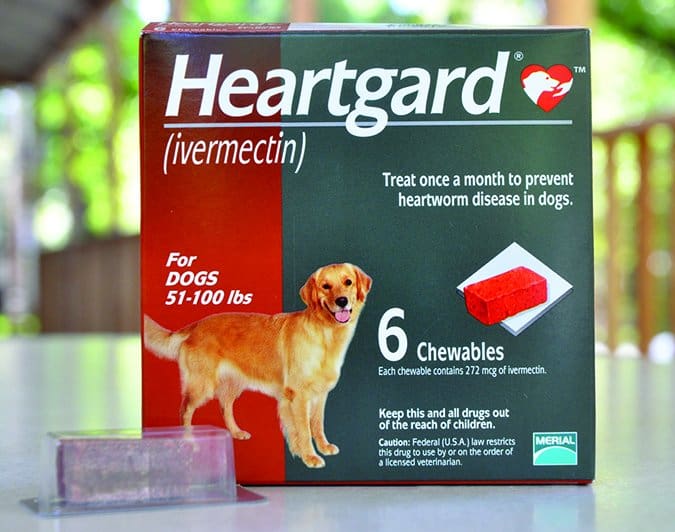
Betsy Harrison of Wimberley, Texas, a former veterinarian who decided to pursue a career as a homeopath, did treat some dogs with the “slow kill” method when she was practicing. She points out that the ivermectin stops new worms from infecting the dog, and “eventually the adults that are there will die of their own accord, and they’ll only die one or two at a time,” mitigating the risks of a massive die-off. As for concerns about permitting heartworms to continue to live in the dog while the long-term kill off takes place, she turns the table to ask: “How much damage is the arsenic doing?” (The counter to this argument is that the Immiticide is cleared rapidly from the body, whereas it could take years for heartworms to die.)
Unlike some holistic-minded practitioners, Harrison does not have a problem with the judicious use of ivermectin, though she notes that care must be taken with those breeds, in particular collies and sheepdogs, that have a genetic sensitivity to the drug. “I don’t think it’s all that toxic,” she says. (Some veterinarians have an altogether different concern about using ivermectin to treat heartworm, arguing that it will lead to resistance to the drug over time.)
Harrison adds that constitutional treatment, to restore and bolster the vital force of the dog, would be the homeopathic approach. “From the homeopathic perspective, the issue is always the health of the overall system,” she explains, adding that a good, biologically appropriate diet is an important starting point. “Worms are kind of like a bacterial infection; they are a reflection of the animal’s state of health more than a disease in and of themselves.”
Surgical Intervention for Heartworm
In some advanced cases, surgery can be performed to remove the heartworms while they are still alive, eliminating the need for the body to clear out the debris from heartworm die-off.
In the procedure, similar in approach to an angioplasty in humans, the veterinary surgeon makes an incision over the jugular vein, then uses special grasping forceps to inch her way to the pulmonary arteries, where the worms are extracted.
“You don’t damage the lungs themselves – you stay within the blood vessels,” explains Dr. Maisenbacher, who performed the surgery many times during his previous tenure at the College of Veterinary Medicine at the University of Florida in Gainesville. “The benefit is that the body doesn’t have to clean the worms out after they die off. But the downside is that it requires general anesthesia, which is much higher risk,” especially for dogs whose bodies have been compromised by a heavy worm load.
Because the surgery is highly specialized, requiring advanced imaging equipment and extensive post-operative care, veterinarians who perform it will likely be located at veterinary schools and large specialty hospitals. And the price tag is steep, potentially $2,000 to $3,000.
In the most advanced heartworm cases, the large number of worms in the pulmonary arteries reduces blood flow, and the dog may cough, be lethargic, and even faint and collapse. Inside the lungs, the worms begin to fall back through the vena cava into the right chamber of the heart, giving this severest form of the disease its name: cava syndrome.
In these cases, worm die-off in the heart cavity is not an option; the worms must be surgically removed before they compromise cardiac function. Though this surgery is slightly less complicated than removing worms from the pulmonary arteries (the veterinarian goes directly into the right atrium of the heart), the prognosis is worse. “In dogs with cava syndrome, the liver, kidneys, and lungs are all compromised, and anesthesia alone can destabilize them,” Dr. Maisenbacher says. “In those cases, the survival rate is 50 percent – not good.”
Non-Active Duty
Pat Collins of Lapeer, Michigan, had two of her English Cocker Spaniels come up positive for heartworm last year after they spent time in Louisiana: 2-year-old Isaac and 3-year-old Jackie.
Collins opted to use the conventional Immiticide treatment, and her anxiety about the treatment centered around the injection itself. “That scared me,” she admits. “Jackie is very soft, and it scared me that she wouldn’t be able to handle the deep muscle injection next to the spine.”
Like any drug, Immiticide can cause allergic reactions, says Wendy Mandese, DVM, a clinical assistant professor at the University of Florida College of Veterinary Medicine. “And like with any caustic substance, sometimes there’s administration error, like the injection being given too close to the surface of the skin.” Experienced veterinarians scrub the skin surface thoroughly, give the needle a half-turn before removing it to avoid tracking the drug up through the injection site, and hold their finger over the hole, creating pressure so the drug doesn’t travel upward through the needle track.
Collins’ fears turned out to be unfounded: Both dogs returned from the vet’s office with a few days’ worth of pain meds and no major side effects, basically sailing through the medical process.
Keeping her two dogs confined for two months was “extremely difficult for both them and me,” Collins says – in particular for the very active Isaac. While she took both dogs on frequent leash walks, “it was very hard to keep him from running and jumping up on furniture. I let him play with his toys a little bit, but I didn’t want him to get wound up and start panting.”
“We don’t want that heart pumping and blood flowing at a high rate while the worms are dead or dying,” Dr. Mandese explains. “Walking around the house and short, on-leash walks are okay. But you don’t want the dog tearing around.”
Creativity counts in situations such as these, and mental exertion is a must. Owners can use this time to fine-tune training and teach targeting, tricks, or other desired behaviors … anything that the dog can master, provided the training process doesn’t get him too excited. That old standby, the Kong stuffed with peanut butter, then frozen, can help wile away a few hours. So can puzzle-style toys, like the Buster Cube.
“We have on occasion prescribed sedation, just to take the edge off,” says Dr. Mandese, who has used Acepromazine and even Xanax to send a tough customer off to a dreamier place. Diffusing calming essential oils such as lavender, or pheromone-release products such as the D.A.P. diffuser, may also help.
Find a Heartworm Treatment That Works for Your Dog
As with all things in life, balance is important. Jogging with a dog undergoing treatment would be clearly dangerous and irresponsible, but, Sockness says, it’s important to remember that “emotionally you can’t shut down a dog, either, because that’s part of their immune system.” While a dog’s activity needs to be curtailed, “let them enjoy a lifestyle.”
She also cautions against taking a sky-is-falling approach. “If your dog tests positive for heartworm, don’t call 911 and freak out,” she says. “You have options. Heartworm is not a death sentence.”
Dodge – who says the day the results came back proclaiming her dog Holly to be heartworm negative was “the best day of my life” – also recommends taking the long view. “It is not the end of your dog’s life!” she echoes. “Search for facts, especially from your vet, and follow the instructions. Stay calm – if you are scared and nervous, the dogs sense it.”
No matter what your treatment approach you take, tender loving care is compatible with all of them. “Baby your baby, spoil him!” she urges. “Do anything to get both of your minds off what you and your dog are going through.” And, of course, the best cure for what ails them – and you? “Lots of kisses.”
Denise Flaim of Revodana Ridgebacks in Long Island, New York, shares her home with three Ridgebacks, 10-year-old triplets, and a very patient husband.


